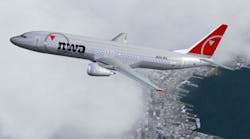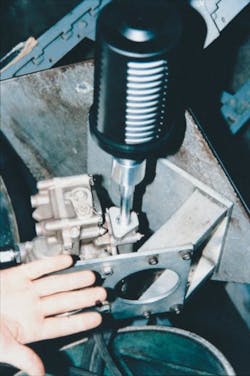There's nothing like a little peace and quiet. This phrase is particularly meaningful for those who work at manufacturing facilities where pumps, motors, valves, and other air-operated equipment keep things abuzz. Now, thanks to a new pneumatic muffler developed by the 3M Bonding Systems Division, St. Paul, Minn., worker comfort levels, as well as noise limits established by the Occupational Safety and Health Administration's (OSHA) Hearing Conservation Program, may be within reach.
Just ask Northwest Airline's pneumatic shop manager Jacques Mezin and Fluid and mechanical accessories manager Robert Steele. Working in a shop-repair and overhaul facility for pneumatic components in the Northwest Airline's fleet, the two encounter a great deal of noise every day. "Testing air cycle machines, starters and flow pressure regulating valves make our facility noisy," explained Mezin. "We had one valve in particular that was very loud. So we fabricated an adapter to the valve port to try the muffler. We saw a reduction in noise of more than 30 dB, without sacrificing production."
Under OSHA's program, employees are required to wear ear protection in working conditions where noise levels exceed 90 dB. The pneumatic muffler can help reduce equipment noise considerably and in some instances completely eliminate the need to wear earplugs.
The muffler is comprised of a rugged polymer housing with a replaceable acoustic composite insert, designed to effectively quiet the exhaust on air-operated equipment. It is porous to air and fluids, helping to minimize back pressure.
Most of the real noise is generated around the test cells and test benches. On average, there are 30 people testing various types of equipment periodically throughout the day, with the number dropping to 15 at night — thus, high noise levels are present almost continuously. Northwest installed five mufflers on one test bench and saw a noticeable difference — enough that workers are no longer required to wear ear plugs when conducting some tests and other workers are no longer aware that tests are being done.
Joe Nelson, plant safety engineer for a 3M manufacturing facility in Aberdeen, S.D., agrees that the new mufflers can speak volumes to employees. "We've been using the mufflers at our facility for about nine months. When our machine operators noticed the difference the pneumatic mufflers were making, they wanted them on all the equipment. Now more than 80 of our 300 employees, who were required to wear earplugs or muffs to protect their hearing, no longer have to. In fact, we can actually hear mechanical cylinders actuating. Before, all we ever heard was a lot of air."
The muffler is engineered for long service life. It can last for weeks, even years, depending on the in-use environment. Factors such as intermittent or continuous use, the cleanliness of supplied air, amount of oil or dirt in the environment, and the malfunction of pneumatic equipment can all affect the insert's service life. At the end of its service life, the insert need only be replaced — not the entire muffler.
A threaded cap screws on to retain the insert, making replacement quick and easy. The disposable core eliminates the need for cleaning with solvents. It can be disposed of with standard methods, eliminating the need for special handling. Six sizes range fit 1/8 to 1 in. NPT ports. The muffler's housing is non-corrosive and its simple aesthetic lines complement modern designs.
"These mufflers have definitely made a world of difference to us," Steel concluded. "We continue to come up with innovative ways to use them."


